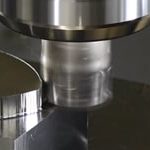Cleared for takeoff
Cleared for takeoff
END USER: Superior Drilling Products, (435) 789-0594, www.superiordrillingproducts.com. CHALLENGE: Without prior experience, program a multitask machine. SOLUTION: Using CAM software with online training resources and local support. SOLUTION PROVIDERS: CNC Software Inc., (800) 228-2877, www.mastercam.com; Remote Machine, (801) 942-2792, www.remotemachinecnc.com
---------------
END USER: Superior Drilling Products, (435) 789-0594, www.superiordrillingproducts.com. CHALLENGE: Without prior experience, program a multitask machine. SOLUTION: Using CAM software with online training resources and local support. SOLUTION PROVIDERS: CNC Software Inc., (800) 228-2877, www.mastercam.com; Remote Machine, (801) 942-2792, www.remotemachinecnc.com
----------------
Superior Drilling Products, Vernal, Utah, repairs drill bits for the oil and gas industry. The 3"- to 24"-dia. bits feature tungsten-carbide bodies tipped with PCD. SDP rebuilds the bodies, replaces the cutting edges and regrinds complex bit contours to customer specifications. Founded in 1993 by Troy Meier and his wife, Annette, SDP pioneers new repair techniques that support the global bit rental market.
SDP also seeks ways to help its customers succeed. One of those customers was struggling to machine a complex, approximately 7"-dia., 14"-long, 4145 steel reamer. The machining operations included turning on a lathe, threading on another machine, contour milling on a machining center and pocketing on yet another machine. The lengthy process was expensive and caused production backlogs.

Courtesy of Superior Drilling Products
CAM programmer Jared Spencer (seated) discusses details of a Mastercam CAM program with David Gale, manufacturing manager.
Meier volunteered to find a way to efficiently produce the reamer and reasoned the operations could be consolidated on a multitask machine. With the guidance of Hartwig Inc. representative Lynn Smith, he acquired an Okuma Multus-B400 7-axis multitask machine. Because the machine mills, drills and turns, it produces parts in one chucking. To program the reamer, SDP bought a seat of Mastercam X5 Mill CAD/CAM software from CNC Software Inc., Tolland, Conn.
Meier's reasoning, however, involved a leap of faith. SDP's prior machine tool capability was limited to two lathes outfitted as grinders. In addition, the employees assigned to produce the reamer included the company's IT manager, whose background was in TV broadcasting, and an inspection staffer who is also an experienced pilot and flight instructor.
According to David Gale, the former IT manager and current manufacturing manager, "Troy said this machine is coming, here's what I want you to make, figure it out." Jared Spencer, the pilot, was responsible for learning Mastercam to produce toolpaths.
Spencer's familiarity with CAD/CAM was restricted to some architectural CAD study in high school. However, the discipline and focus a pilot requires helped prepare him for programming a CNC machine. "Both are tremendously challenging," he said. "A lot of thought processes go into them."
Spencer received help from Josh Sinykin, who represents Mastercam reseller Remote Machine, Sandy, Utah. Sinykin noted that he frequently works with business startups and is used to dealing with inexperienced programmers. "When we have customers who are inexperienced or even an experienced machinist who gets a new, more capable machine, we go in and help them make sure their code is good and show them how to set up and program their first part."
The major portion of Spencer's CAM education came via CNC Software's online Mastercam University. The video training program offers courses covering programming basics, toolpaths and machining principles. The classes are available 24/7, allowing users to learn at their own pace and at their own locations.
The online training fit Spencer's approach to learning. "I'm a hands-on kind of guy," he said. "I would watch and listen to what the instructor said. If I didn't get the point, I would rewind it and listen again. I didn't have to feel like I was stopping the class and frustrating people who were picking it up faster than me. I could listen to it 10 times if I needed to." The classes are application-oriented, Spencer said, noting that each instructor "shows you on the video the exact thing you are going to see in the software."
With the training, Spencer learned to program toolpaths, import solid models and STL files, work in surfaces and perform various operations, such as engraving. Sinykin pointed out that many colleges employ the online program to enable students to gain Mastercam programming certification as they earn their 4-year degrees.
In October 2010, Spencer accepted responsibility for programming the reamer. November and December were consumed with getting the new multitask machine up and running, and the shop produced a part for customer approval in January 2011. The customer's satisfaction with the reamer SDP produced immediately resulted in contracts for further work.
Just as there are different flight paths to a selected destination, Spencer found that CAM programming offers many ways to accomplish a given task. He said: "Josh showed his way of doing certain things. The instructor on the Mastercam video had some different approaches that made programming even faster. We also have a manufacturing process consultant on staff, and he has been showing me other ways to speed up and improve my programming. Everybody has their own way to get from point A to point B."





